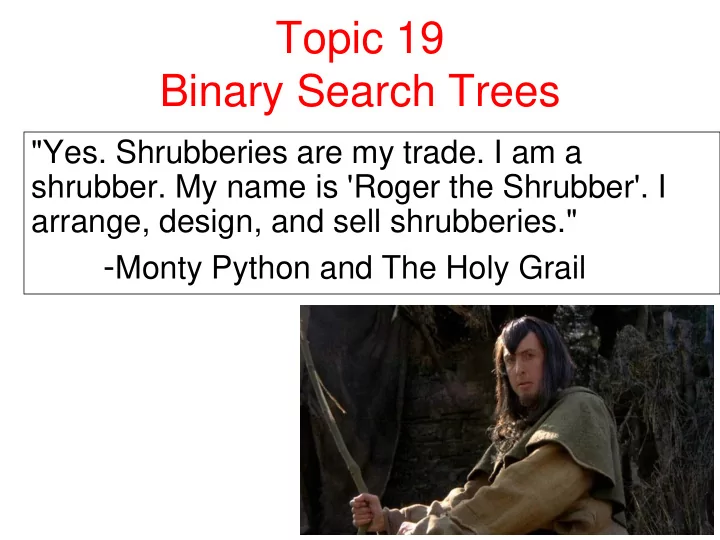

Topic 19 Binary Search Trees "Yes. Shrubberies are my trade. I am a shrubber. My name is 'Roger the Shrubber'. I arrange, design, and sell shrubberies." - Monty Python and The Holy Grail
The Problem with Linked Lists Accessing a item from a linked list takes O(N) time for an arbitrary element Binary trees can improve upon this and reduce access to O(log N) time for the average case Expands on the binary search technique and allows insertions and deletions Worst case degenerates to O(N) but this can be avoided by using balanced trees (AVL, Red-Black) CS314 Binary Search Trees 2
Binary Search Trees A binary search tree is a binary tree in which every node's left subtree holds values less than the node's value, and every right subtree holds values greater than the node's value. A new node is added as a leaf. root parent 17 < > right child 11 19 left child CS314 Binary Search Trees 3
BST Insertion Add the following values one at a time to an initially empty binary search tree using the naïve algorithm: 90 20 9 98 10 28 -25 What is the resulting tree? CS314 Binary Search Trees 4
Traversals What is the result of an inorder traversal of the resulting tree? How could a preorder traversal be useful? CS314 Binary Search Trees 5
Clicker 1 After adding N distinct elements in random order to a Binary Search Tree what is the expected height of the tree? A. O(logN) O(lN 1/2 ) B. C. O(N) D. O(NlogN) O(N 2 ) E. CS314 Binary Search Trees 6
Clicker 2 After adding N distinct elements to a Binary Search Tree what is the worst case height of the tree? A. O(logN) O(lN 1/2 ) B. C. O(N) D. O(NlogN) O(N 2 ) E. CS314 Binary Search Trees 7
Worst Case Performance Insert the following values into an initially empty binary search tree using the traditional, naïve algorithm: 2 3 5 7 11 13 17 What is the height of the tree? What is the worst case height of a BST? CS314 Binary Search Trees 8
Node for Binary Search Trees public class BSTNode<E extends Comparable<E> { private Comparable<E> myData; private BSTNode<E> myLeft; private BSTNode<E> myRightC; public BinaryNode(E item) { myData = item; } public E getValue() { return myData; } public BinaryNode<E> getLeft() { return myLeft; } public BinaryNode<E> getRight() { return myRight; } public void setLeft(BSTNode<E> b) { myLeft = b; } // setRight not shown } CS314 Binary Search Trees 9
More on Implementation Many ways to implement BSTs Using nodes is just one and even then many options and choices public class BinarySearchTree<E extends Comparable<E>> { private BSTNode<E> root; private int size; CS314 Binary Search Trees 10
Add an Element, Recursive CS314 Binary Search Trees 11
Add an Element, Iterative CS314 Binary Search Trees 12
Clicker Question 3 What are the best case and worst case order to add N distinct elements, one at a time, to an initially empty binary search tree using the simple add algorithm? // given int[] data Best Worst // no duplicates in A. O(N) O(N) // data BST<Integer> b = B. O(NlogN) O(NlogN) new BST<Integer>(); for(int x : data) C. O(N) O(NlogN) b.add(x); O(N 2 ) D. O(NlogN) O(N 2 ) O(N 2 ) E. 13
Performance of Binary Trees For the three core operations (add, access, remove) a binary search tree (BST) has an average case performance of O(log N) Even when using the naïve insertion / removal algorithms – no checks to maintain balance – balance achieved based on the randomness of the data inserted CS314 Binary Search Trees 14
Remove an Element Three cases – node is a leaf, 0 children (easy) – node has 1 child (easy) – node has 2 children (interesting) CS314 Binary Search Trees 15
Properties of a BST The minimum value is in the left most node The maximum value is in the right most node – useful when removing an element from the BST CS314 Binary Search Trees 16
Alternate Implementation In class examples of dynamic data structures have relied on null terminated ends. – Use null to show end of list, no children Alternative form – use structural recursion and polymorphism CS314 Binary Search Trees 17
BST Interface public interface BST { public int size(); public boolean contains(Comparable obj); public boolean add(Comparable obj); } CS314 Binary Search Trees 18
EmptyBST public class EmptyBST implements BST { private static EmptyBST theOne = new EmptyBST(); private EmptyBST(){} public static EmptyBST getEmptyBST(){ return theOne ; } public BST add(Comparable obj) { return new NEBST(obj); } public boolean contains(Comparable obj) { return false ; } public int size() { return 0; } } CS314 Binary Search Trees 19
Non Empty BST – Part 1 public class NEBST implements BST { private Comparable data; private BST left; private BST right; public NEBST(Comparable d){ data = d; right = EmptyBST. getEmptyBST (); left = EmptyBST. getEmptyBST (); } public BST add(Comparable obj) { int val = obj.compareTo( data ); if ( val < 0 ) left = left.add( obj ); else if ( val > 0 ) right = right.add( obj ); return this ; } CS314 Binary Search Trees 20
Non Empty BST – Part 2 public boolean contains(Comparable obj){ int val = obj.compareTo(data); if ( val == 0 ) return true ; else if (val < 0) return left.contains(obj); else return right.contains(obj); } public int size() { return 1 + left.size() + right.size(); } } CS314 Binary Search Trees 21
Recommend
More recommend